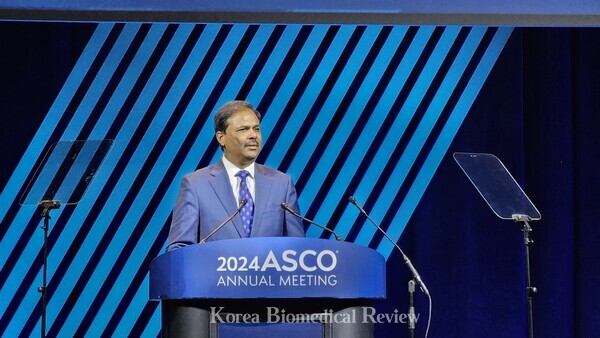CHICAGO, Ill. -- By Lee Han-soo/Korea Biomedical Review correspondent – In a groundbreaking presentation at the ASCO 2024 plenary session on Sunday, Professor Suresh S. Ramalingam at the Winship Cancer Institute of Emory University presented the LAURA study, which revealed that AstraZeneca’s Tagrisso (ingredient: osimertinib), a third-generation EGFR-TKI, significantly improves progression-free survival (PFS) in patients with unresectable stage III EGFR-mutant non-small cell lung cancer (NSCLC) following definitive chemoradiotherapy (CRT).

This study complements the ADAURA study findings, positioning osimertinib as a versatile treatment across all stages of EGFRm NSCLC.
The global, double-blind, placebo-controlled phase 3 LAURA study enrolled 216 patients aged 18 years and older, 20 years and older in Japan, who had not progressed after platinum-based CRT.
These patients were randomized in a 2:1 ratio to receive either osimertinib or a placebo. The primary endpoint was PFS assessed by blinded independent central review (BICR), with secondary endpoints including overall survival (OS) and safety.
The results were nothing short of remarkable. Patients treated with osimertinib demonstrated a median PFS of 39.1 months compared to just 5.6 months for those receiving the placebo.
This translates to a hazard ratio (HR) of 0.16 (95% CI 0.10, 0.24; p<0.001), indicating a substantial reduction in the risk of disease progression or death. At 12 months, the PFS rate was 74 percent for osimertinib compared to 22 percent for placebo, and at 24 months, the rates were 65 percent versus 13 percent, respectively.
When combining this with the ADAURA study findings, it positions osimertinib as a versatile treatment across all stages of EGFRm NSCLC.
The ADAURA study, a phase 3 trial, evaluated osimertinib as adjuvant therapy in patients with resected stage IB-IIIA EGFR-mutant NSCLC.
The study demonstrated that adjuvant osimertinib therapy, with or without previous adjuvant chemotherapy, resulted in significantly longer disease-free survival than placebo.
In the overall population of patients with stage IB to IIIA disease, the 5-year overall survival was 88 percent for the osimertinib group compared to 78 percent for the placebo group (HR for death, 0.49; 95.03% CI, 0.34 to 0.70; P<0.001).
When asked if the team is expecting similar OS data in the LAURA study for stage 3, similar to the recently presented PFS data, given that osimertinib showed an impressive 5-year OS rate of 88 percent in the ADAURA study for stages 1-3, Professor Ramalingam stressed that while the overall survival results are not mature, he is hopeful to have those results in the next 18 to 24 months.
“Interim OS data showed a positive trend in favor of osimertinib, despite a high proportion of patients crossing over to osimertinib in the placebo arm (81 percent),” he said.
Implications for treatment
The LAURA study's findings, combined with the ADAURA study results, are poised to change the treatment landscape for unresectable EGFRm NSCLC.
The safety profile of osimertinib was consistent with expectations, with manageable side effects.
Although, 98 percent of patients experienced adverse events (AEs), with 35 percent experiencing Grade 3 or higher AEs, and 38 percent reporting serious AEs, Ramalingam stressed that safety profile of osimertinib post CTR was as expected and manageable and that the benefits clearly outweigh the risks.
"Osimertinib has clearly provided benefit in all stages of non-small cell lung cancer," Ramalingam said. "In the U.S., it’s the most commonly used frontline treatment, and while other third-generation EGFR-TKIs are being developed and reported upon in different parts of the world, at least in the U.S., we can say that osimertinib has taken the position as the go-to drug."
The full impact of these findings will continue to unfold as more data becomes available, but for now, the LAURA study, in conjunction with ADAURA, marks a significant milestone in the fight against lung cancer, establishing osimertinib as a cornerstone treatment for EGFRm NSCLC across all stages.
Related articles
- [Photo News] Leading pharma giants unveil cutting-edge oncology research at ASCO 2024
- [ASCO2024] Durvalumab shines as consolidation therapy for limited-stage SCLC
- [ASCO2024] Lunit's AI software aims to enhance accuracy in detecting HER2 ultralow levels
- [ASCO2024] Moderna's individualized neoantigen therapy shows broad efficacy in cancer treatment
- [ASCO 2024] Korean researchers highlight precision medicine advances with KOSMOS-II study findings
- Young-PEARL study’s survival data marks new milestone in premenopausal breast cancer at ASCO 2024
- [Reporter’s Notebook] Korea's clinical trial successes threatened by government policies, staffing shortages
- AstraZeneca Korea’s oral D-factor inhibitor Voydeya approved for PNH treatment
- Bridge Biotherapeutics advances phase 1 study of BBT-207 in NSCLC
- New treatment for EGFR-mutant NSCLC: Tagrisso combined with chemotherapy approved
- Ways found to save patients with meningeal metastatic EGFR-mutant lung cancer
- AstraZeneca's Tagrisso reaffirms its global standing in lung cancer treatment

